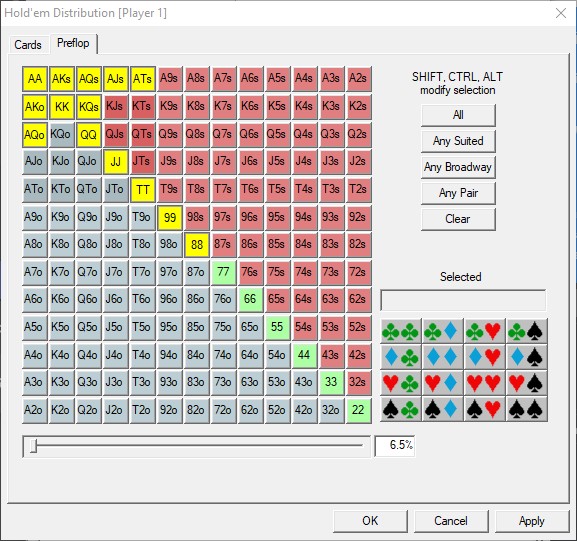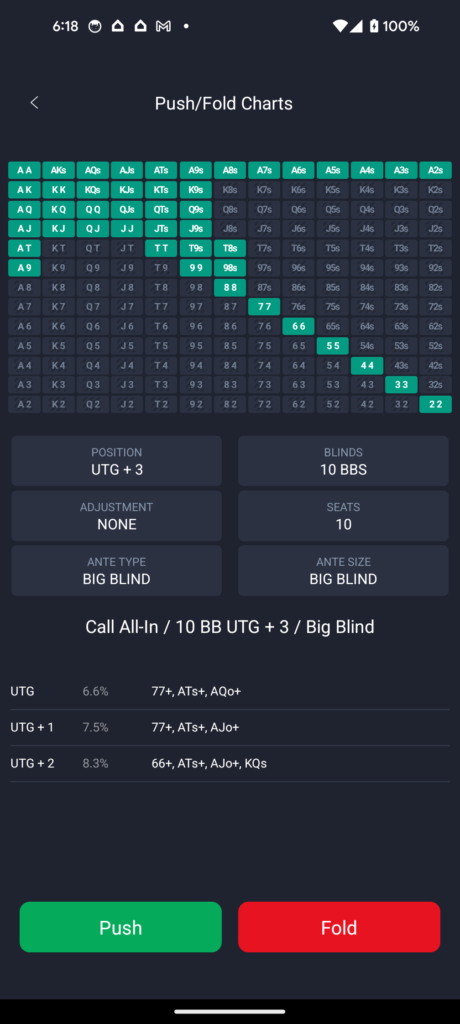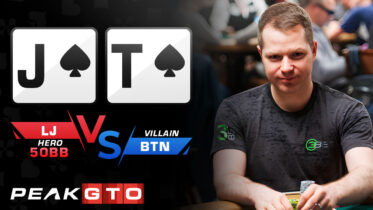Sit-and-go poker tournaments used to be the bread and butter of online poker players. While they are no longer as popular, sit-and-gos are still a great way to get started with the game.
As the name suggests, sit-and-go tournaments start as soon as enough players join, typically include a few players, and last a short time.
This makes them a great opportunity to learn how to play poker and prepare for late-stage play in future multi-table tournaments you might play.
Whether you want to grind SNG tournaments for a profit or use them as a learning tool for MTTs, we are here to help.
The following is a list of sit-and-go poker strategy tips that will help you become a player in a very short time and take your tournament game to the next level.
- Sit and Go Strategy Tip #1 – Play Tight Early
- Sit and Go Strategy Tip #2 – Be Mindful of Position
- Sit and Go Strategy Tip #3 – Always Know Your Stack Size
- Sit and Go Strategy Tip #4 – Be Willing to Shift Gears
- Sit and Go Strategy Tip #5 – Take Some Calculated Risks
- Sit and Go Strategy Tip #6 – Don’t Panic on a Short Stack
- Sit and Go Strategy Tip #7 – Master the Push-Fold Charts
- Sit and Go Strategy Tip #8 – Practice ICM
- Sit and Go Strategy Tip #9 – Have Realistic Expectations
- Sit and Go Strategy Tip #10 – Learn How to Play Heads-Up
Sit and Go Strategy Tip #1 – Play Tight Early
Sit and go tournaments don’t last very long, and the early stage typically lasts for only a few levels, with each level taking no more than 10 minutes to play out.
However, it is essential to be patient during this stage of SNGs, as you will usually have quite a few blinds to play with, and your opponents will be less likely to stack off for no reason.

In early-stage SNG play, you should be looking to enter pots with a fairly narrow range of hands. This range should not include many bluffs and should lean more heavily towards value.
You should be especially careful in early positions, where only the best hands, like big pocket pairs and AK, are worth entering the pot with.
In later positions and the blinds, you will get some chances to play speculative hands like suited connectors and small pocket pairs. These hands are good because they can allow you to win a whole stack if you flop big.
Yet, don’t go too far in chasing draws either, and generally stick to the adage “tight is right” in early sit and go play.
Sit and Go Strategy Tip #2 – Be Mindful of Position
Position is everything in poker, and in sit-and-go tournaments, there is no substitute for being positionally aware.
If you play too many hands from early position and constantly find yourself OOP, you will not be able to break even playing sit-and-gos.
Whether you are opening the pot with a raise or calling a small raise with a speculative hand, doing so in position will allow you to realize your equity more often, bluff more often, and generally win more pots.
You should be especially mindful of calling 3-bets and 4-bets out of position, as playing a big pot out of position is even worse than playing a small one.
The only times you should not really care too much about your position is when you get dealt monsters, as you want to play these hands in any position.
However, if you are holding KK or AA and a player in position is getting aggressive with you, play right back at them and don’t wait for the flop, as it might be difficult to get all the money in once the flop is dealt.
Sit and Go Strategy Tip #3 – Always Know Your Stack Size
While keeping track of the exact number of big blinds might not be essential in cash games, as you are usually playing very deep, SNG players must know exactly how many big blinds they have at all times.
Being aware of your stack and every other stack at the table is essential. Your stack size and the stack sizes of your opponents should drive every decision you make in an SNG.
Your big blind count will become increasingly important as the tournament progresses, especially on the bubble and once you are in the money.
Once you know how many chips you are playing for, you will be able to accurately use any push-fold strategy you have learned and apply your understanding of ICM and other important SNG concepts to the game.
Sit and Go Strategy Tip #4 – Be Willing to Shift Gears

We have suggested that the best sit-and-go poker strategy is to play tight in the early rounds. However, it also involves becoming much more aggressive as the blinds go up.
Once the antes are in play and the blind-to-stack ratio has changed, it is time to start stealing those blinds, sometimes quite aggressively.
You will want to raise a lot more in late positions once the blinds go up and the mid-stages of the tournament begin, as this is the right time for chip accumulation.
By raising wider, you will get a chance to pick up more dead money, but also get more action when you actually do have a big hand.
Stealing blinds and re—stealing against steal attempts is the essence of SNG strategy, and you will only ever become a truly great SNG player when you learn how to apply these concepts in play.
Sit and Go Strategy Tip #5 – Take Some Calculated Risks
While sit and goes are certainly a game of patience, there is also a time to take some fairly big risks that will allow you to win more often.
If you have been playing tight and not making any big moves for a while, you may want to find a good moment for a big steal with a bluff hand like A5s once in a while.
For example, imagine you are in the mid stages of an SNG and open the button, only to have an aggressive player in the big blind 3-bet you.
You know your opponent is likely re-stealing, but you also don’t want to call and allow them to c-bet the flop and win the pot from underneath you.
This is a great time to take a risk and push all in, making your opponent often fold hands as strong as AQ or TT.
Of course, remember that big plays like this must be made at the right time and against the right opponent, which is why being mindful of your opponents’ images can also be a key component of a good SNG strategy.
Sit and Go Strategy Tip #6 – Don’t Panic on a Short Stack
Being a short stack in a sit-and-go tournament is something that will happen all the time if you play these games regularly.
Instead of going into panic mode and trying to rebuild your stack by force, remain patient and play every hand correctly.
Keep track of the exact number of big blinds you have and play according to the strategies you have learned. Don’t let emotions get in the way.
Once the blinds go up, you will only need a couple of double-ups to get right back in the game, and those will become easy to come by if you wait for the right moment.
Since there are only so few players in the entire field, surviving is a lot more important than chipping up, so hang in there and wait for the right spot to win your chips back.
Sit and Go Strategy Tip #7 – Master the Push-Fold Charts

The truth is that a lot of gameplay in SNG tournaments comes down to folding your cards or going all-in, and this is especially true in turbo and hyper-turbo games.
As you get into the later stages of the tournament, you will want to know which hands you can profitably shove from different positions with different stacks.
The only way to really know this is to study push-fold charts and memorize the different ranges to shove in different spots.
One pro tip we can give you is not to try and remember every hand in a push range for a particular stack size and position.
Instead, remember the worst hands you want to shove in a given scenario. By knowing these, you will understand that all better hands are also worth shoving.
Studying push-fold charts for a long time will allow you to visualize them in your head and always have access to them, even when you are not looking at them while playing.
Sit and Go Strategy Tip #8 – Practice ICM
An independent chip model (ICM) is critical to SNG players, as they constantly find themselves in spots where ICM implications are significant.
If you want to master the SNG game, practicing with an ICM tool is key, as this is the only way to actually become good at making the right ICM plays.
Remember that ICM kicks in very early in SNGs, and as soon as players start dropping and stacks start to change, there will be ICM implications to take into consideration.
Even if you are playing very low-stakes SNGs, being good at making the right ICM play will make a massive difference and allow you to win at a higher win rate than other players in the same games.
Sit and Go Strategy Tip #9 – Have Realistic Expectations
One thing that confuses people in SNGs is that even the best players win at a very low rate.
The nature of sit-and-go tournaments is that they are very fast and offer few opportunities to show off your skills, leading to a low win rate.
However, even a 5% ROI can go a long way in SNGs, as these games can be easily multi-tabled and are very fast to play out.
If you can play 100 games at 5% ROI in a few hours, you’ll make 5 full buyins during that period, which is a pretty good return.
However, don’t expect to print money and move through the levels at a crazy pace, and be aware that other players are also studying the game and trying to make a profit the same way you are.
Also, be prepared for a lot of variance, as SNG tournaments can be brutal in this segment and lead to some pretty big downswings when luck shuts the door.
Sit and Go Strategy Tip #10 – Learn How to Play Heads-Up
While multi-table tournament players only find themselves playing heads-up on rare occasions, SNG players get there quite often.
If you want to grind sit-and-go consistently, being solid in heads-up play is necessary. Otherwise, you will be losing tons of value every time you reach the final two.
One great way to practice heads-up play is to fire up some heads-up SNGs every day before your SNG session, and practice just heads-up play exclusively.
Spending some time learning about heads-up during your study sessions will have a great impact on your bottom line, especially if your opponents are not well-versed in heads-up play.
Ultimately, you may even want to focus on heads-up SNGs exclusively and play those as your main game, as this will allow you to move up the stakes even faster and win with a higher overall win rate against weaker opponents.





